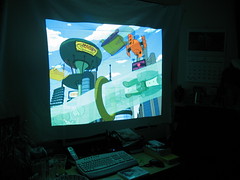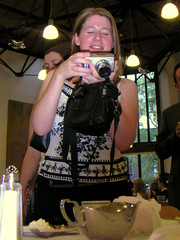At the start of the month, Channel4's film channel, Filmfour went free to view. This means it is available free on Sky (315), cable( 701/50NTL - 444-Telewest) and Freeview (31). From next week they are showing a season of Miyazki films starting with his directorial debut, Castle of Cagliostro, a film in the Lupin III series. The full timetable is:
Fri 04 - 4:55 PM - The Castle of Cagliostro
Sat 05 - 4:45 PM - Kiki's Delivery Service
Sun 06 - 4:30 PM - Princess Mononoke
Mon 07 - 4:55 PM - Castle in the Sky
Tue 08 - 5:10 PM - My Neighbour Totoro
Wed 09 - 4:45 PM - Nausicaa of the Valley of Wind
Thu 10 - 5:15 PM - Porco Rosso
Fri 11 - 4:45 PM - Princess Mononoke
Sat 12 - 5:05 PM - My Neighbour Totoro
Sun 13 - 4:55 PM - Castle in the Sky
Mon 14 - 5:05 PM - Kiki's Delivery Service
Tue 15 - 4:45 PM - Nausicaa of the Valley of Wind
Wed 16 - 4:45 PM - Porco Rosso
Thu 17 - 5:10 PM - The Castle of Cagliostro
No Spirited Away or Howl's Moving Castle, but still a selection of some of the most timeless films ever created.
Wednesday, July 26, 2006
Global recognition for Ghibli - Spirited Away
After 1997's Mononoke Hime, Miyazaki was considering retiring from animation. An encounter with a friend's young daughter persuaded him that he had more stories to tell. He wrote a piece for this girl called Sen to Chihiro no kamikakushi (Spirited Away). With this film, Ghibli finally earned themselves worldwide recognition as Sen to Chihiro no kamikakushi won the 2003 oscar for best animated film beating Ice Age and Lilo & Stitch. This earned the film a longer run in US cinemas and even a UK cinemas release in the late summer of 2003. The film follows the adventures of a sullen 10 year old girl called Chihiro. She is spoilt and bored by life. As her family are moving house her parents car comes across a strange tunnel in the woods. Her parents decide to investigate and take Chihiro with them. As her parents settle down to eat at what they assume is a restaurant, Chihiro goes exploring. A mysterious boy warns her that she should not have come and urges her to get out. Frightened, she runs back to where her parents are only to find they have turned into pigs. As darkness falls, strange spirits arrive in the town and head towards the large bath house. Chihiro is helped by the mysterious boy who tells her that this world is ruled by Yubaba, the sorceress who runs the bath house. If she is to survive and save her parents she must persuade Yubaba to let her work at the baths. The deal involves Yubaba taking Chihiro's name, or more precisely taking some of the kanji from it leaving her name as Sen. Once someone forgets their real name they are forever trapped in the spirit world. As Sen struggles to fit in and find courage in the strange world, all manner of spirits and gods arrive at the bath house demanding service. Sen is taken under the wings of Kamaji - the multiarmed man who provides power for the baths, Lin - another bath house worker and Hakku - the boy who tries to guide her through the pitfalls of the land. She also attracts the interest of Noface, a strange ghost like creature that takes a liking to her.
If Grave of the fireflies was the Ghibli film least likely to be seen, Spirited Away is the film most people will be familiar with. The story is straightforward but the attention to detail, as always is superb. Little touches such as Sen tapping her foot on the floor after she puts her shoes on, the characterisation of the soot spirits in the basement and interactions of background characters help immerse the viewer into the world. The characters too are wonderfully eclectic; Yubaba's gigantic baby, the mysterious bearded heads (whose presence is never really explained) and of course, Noface. Noface exists as a being that seems to feed off greed and corruption. After he is allowed into the baths by Sen he starts to corrupt the workers by offering them gold, but immediately snatches them up. As his corrupting influence spreads so he gets ever larger. After being "cured" by Sen he follows her on trip to find Yubaba's sister, Zeniba, in order to help Hakku. As he gets further away from the bathhouse, he once again becomes passive and calm.
Chihiro starts off grumpy and ill-mannered, but must learn to grow up and deal with life in a very short space of time. By the end of the film, she is repectful and self-assured due to her time in the spirit world; Miyazaki's take on modern Japanese youth. Even the character of Zeniba's lamp - a flick of the hat to Pixar's Luxor Jr - displays great character in the short screen time it gets.
Spirited Away is one of the first Ghibli films to use computers. Thankfully, their presence is limited to a few scenes and largely goes unnoticed. Once again, Joe Hisaishi provides the score and really outdoes himself producing one of the most memorable scores amongst the Ghiblis. The requiem theme will instantly be familiar to anyone who owns an R3 Ghibli as it is used on the trailers. The music helps make the most of some otherwise silent passages of the film. Where as Laputa benefitted from frequent silences, Sen's train journey to the sixth station wouldn't be as magical without the Hisaishi score underneath it.
Of course we know what the outcome of the film will be, but it's a real adventure getting there taking us down many unexpected pathways - the river God's bath, the attack by Zeniba's paper warriors and Noface's rampage through the bath house. Miyazaki's great trick is drawing us into this fantasy world. Just like Chihiro, we never stop to ask what is going on, because it's irrelevant - it is going on and we just have to accept it and adapt to it. This is a wonderful fable - an Alice in Wonderland esque story combined with rich sumptuous visuals and a beautiful score. Simply put, beyond all the messages and morality this is simply a fantastic story told by one of the world's best.
The DVD of Spirited Away is normally available for £5 or less at HMV so you really don't have any excuse not to see this film. If you are willing to spend a bit more, the US R1 version offers a better transfer and is the one to go for.
If Grave of the fireflies was the Ghibli film least likely to be seen, Spirited Away is the film most people will be familiar with. The story is straightforward but the attention to detail, as always is superb. Little touches such as Sen tapping her foot on the floor after she puts her shoes on, the characterisation of the soot spirits in the basement and interactions of background characters help immerse the viewer into the world. The characters too are wonderfully eclectic; Yubaba's gigantic baby, the mysterious bearded heads (whose presence is never really explained) and of course, Noface. Noface exists as a being that seems to feed off greed and corruption. After he is allowed into the baths by Sen he starts to corrupt the workers by offering them gold, but immediately snatches them up. As his corrupting influence spreads so he gets ever larger. After being "cured" by Sen he follows her on trip to find Yubaba's sister, Zeniba, in order to help Hakku. As he gets further away from the bathhouse, he once again becomes passive and calm.
Chihiro starts off grumpy and ill-mannered, but must learn to grow up and deal with life in a very short space of time. By the end of the film, she is repectful and self-assured due to her time in the spirit world; Miyazaki's take on modern Japanese youth. Even the character of Zeniba's lamp - a flick of the hat to Pixar's Luxor Jr - displays great character in the short screen time it gets.
Spirited Away is one of the first Ghibli films to use computers. Thankfully, their presence is limited to a few scenes and largely goes unnoticed. Once again, Joe Hisaishi provides the score and really outdoes himself producing one of the most memorable scores amongst the Ghiblis. The requiem theme will instantly be familiar to anyone who owns an R3 Ghibli as it is used on the trailers. The music helps make the most of some otherwise silent passages of the film. Where as Laputa benefitted from frequent silences, Sen's train journey to the sixth station wouldn't be as magical without the Hisaishi score underneath it.
Of course we know what the outcome of the film will be, but it's a real adventure getting there taking us down many unexpected pathways - the river God's bath, the attack by Zeniba's paper warriors and Noface's rampage through the bath house. Miyazaki's great trick is drawing us into this fantasy world. Just like Chihiro, we never stop to ask what is going on, because it's irrelevant - it is going on and we just have to accept it and adapt to it. This is a wonderful fable - an Alice in Wonderland esque story combined with rich sumptuous visuals and a beautiful score. Simply put, beyond all the messages and morality this is simply a fantastic story told by one of the world's best.
The DVD of Spirited Away is normally available for £5 or less at HMV so you really don't have any excuse not to see this film. If you are willing to spend a bit more, the US R1 version offers a better transfer and is the one to go for.
Ghibli's hidden masterpiece - Grave of the Fireflies
There are some films that deserve to be seen by everyone in the world. Hotaru no haka (Grave of the Fireflies) is one of these films. It's often overlooked as a Ghibli film as it wasn't directed by Miyazaki, but instead his partner, Isao Takahata. The film is based on the semi-autobiography of Akiyuki Nosaka, who wrote the book to deal with his survivors guilt. People often overlook animation as being for kids or associate it with porn and violence. However, the fact reamins that Hotaru no haka remains the single most important war film ever made. It may seem strange that, beyond the first few minutes, there hardly any violence. Instead, the film is very gentle. It features on US film critic Roger Ebert's list of 100 greatest films of all time.
The story opens in Kobe during the final days of WW2 - a starving child clutching a sweet tin eventually slips into death. We move backwards in time some weeks. US forces bombard the Japanese mainland with napalm bombs. Seita, 14, and his younger sister Setsuko are separated from their mother on their way to the shelter. The following day Seita finds her dying in an emergencey hospital, her body so burned that he can't let Setsuko see her. With almost everything they have gone and their father away serving with the navy, the children go to live with the their aunt on the outskirts of the city. She is initially happy to see them as their posessions such as their mother's kimonos can be sold to buy food. As this source of money runs out she grows bitter at having to house and feed someone elses children. Eventually Seita can't take it anymore and leaves with Setsuko to live by themselves. They find an old bomb shelter and set up a home there with Seita finding food anyway he can as Setsuko starts to show the early stages of malnutririon. Although Seita has money, it soon becomces worthless as there is simply no food to buy.
From the opening line "September 21, 1945... that was the night I died", we are left in no doubt as to how this film ends. We are forced to sit and watch as Setsuko's health deteriorates. We see how Seita tries his hardest for his sister, but this kind of responsibility is far too great to be placed on one so young. The film makes absolutely no statements about the Americans - in fact, they are never mentioned, refered to only as "the enemy". It would be far too easy to criticise the military decision taken to firebomb civilian towns where the majority of housing was made from wood and paper, but the film avoids this angle completely. Where it succeeds as a war film is showing how war affects the innocent - those who not only don't understand the fighting, but are too young to cope with the consequences. We see how in a time of shortages, imminent defeat and hopelessness, people ignore the plight of these children. No one comes to their aid - they are left completely alone. This isn't the fault of the population - the war has created only victims. Society has become unable to protect those who need it most
The film has its moments of happiness to avoid sliding into melodrama. Seita and Setsuko's discoverly of the fireflies lighting their shelter brings a joyous wonder to the young girl's face. It's these scenes that remind us that compassion can still exist in even these difficult times.
This film is an experience. Not an epic by any means, it clocks in at only 88 minutes, but it leaves you emotionally drained. A read of the IMDB comments section for this film shows there are large number of people who find it too hard to see the film more than once. This is a film that inspires tears; not those that might sneak out as Bambi's mother dies or that well up at the finale of Eternal Sunshine, but tears of actual grief. By this point, it doesn't matter that the film is animated - it's created more emotion than a live action film could ever do. As mentioned above, the original story was meant as an apology to the author's sister who died of starvation in the war as Nosaka admitted eating food before offering it to his sister.
Originally, the film was released as a double feature with My Neighbour Totoro, which is a coupling of possibly the most polar opposite films I've ever considered. Many school boards chose to show the film to their students to educate them about the horrors of war and how it affect society. This would be an excellent idea worldwide. These children are the "collateral damage" frequently talked about by politicians - dismissed as 2 words. In Japan, the film is broadcast annually on August 6th as a reminder of the costs of war.
Sadly, because of peoples' reaction to animation, the film hasn't received the attention it deserves. It really should be seen by as many people as possible. If you have seen it it's your duty to recommend it to as many people as possible.
The story opens in Kobe during the final days of WW2 - a starving child clutching a sweet tin eventually slips into death. We move backwards in time some weeks. US forces bombard the Japanese mainland with napalm bombs. Seita, 14, and his younger sister Setsuko are separated from their mother on their way to the shelter. The following day Seita finds her dying in an emergencey hospital, her body so burned that he can't let Setsuko see her. With almost everything they have gone and their father away serving with the navy, the children go to live with the their aunt on the outskirts of the city. She is initially happy to see them as their posessions such as their mother's kimonos can be sold to buy food. As this source of money runs out she grows bitter at having to house and feed someone elses children. Eventually Seita can't take it anymore and leaves with Setsuko to live by themselves. They find an old bomb shelter and set up a home there with Seita finding food anyway he can as Setsuko starts to show the early stages of malnutririon. Although Seita has money, it soon becomces worthless as there is simply no food to buy.
From the opening line "September 21, 1945... that was the night I died", we are left in no doubt as to how this film ends. We are forced to sit and watch as Setsuko's health deteriorates. We see how Seita tries his hardest for his sister, but this kind of responsibility is far too great to be placed on one so young. The film makes absolutely no statements about the Americans - in fact, they are never mentioned, refered to only as "the enemy". It would be far too easy to criticise the military decision taken to firebomb civilian towns where the majority of housing was made from wood and paper, but the film avoids this angle completely. Where it succeeds as a war film is showing how war affects the innocent - those who not only don't understand the fighting, but are too young to cope with the consequences. We see how in a time of shortages, imminent defeat and hopelessness, people ignore the plight of these children. No one comes to their aid - they are left completely alone. This isn't the fault of the population - the war has created only victims. Society has become unable to protect those who need it most
The film has its moments of happiness to avoid sliding into melodrama. Seita and Setsuko's discoverly of the fireflies lighting their shelter brings a joyous wonder to the young girl's face. It's these scenes that remind us that compassion can still exist in even these difficult times.
This film is an experience. Not an epic by any means, it clocks in at only 88 minutes, but it leaves you emotionally drained. A read of the IMDB comments section for this film shows there are large number of people who find it too hard to see the film more than once. This is a film that inspires tears; not those that might sneak out as Bambi's mother dies or that well up at the finale of Eternal Sunshine, but tears of actual grief. By this point, it doesn't matter that the film is animated - it's created more emotion than a live action film could ever do. As mentioned above, the original story was meant as an apology to the author's sister who died of starvation in the war as Nosaka admitted eating food before offering it to his sister.
Originally, the film was released as a double feature with My Neighbour Totoro, which is a coupling of possibly the most polar opposite films I've ever considered. Many school boards chose to show the film to their students to educate them about the horrors of war and how it affect society. This would be an excellent idea worldwide. These children are the "collateral damage" frequently talked about by politicians - dismissed as 2 words. In Japan, the film is broadcast annually on August 6th as a reminder of the costs of war.
Sadly, because of peoples' reaction to animation, the film hasn't received the attention it deserves. It really should be seen by as many people as possible. If you have seen it it's your duty to recommend it to as many people as possible.
Back to Ghilbi with Monononke Hime
If I've timed this right, the rest of my Miyazaki Ghibli reviews should appear on the day of release in Japan of the studio's latest film, Gedo Senki (Tales of Earthsea). I'm now going back to talk about the first Ghibli I (knowingly) saw. Back in the early days of 2002 I was reading a film website called DVD Times and browsed through a couple of reviewers choices of DVDs of the year. One reviewer picked out the R2J release of Mononoke Hime (Princess Mononoke). His praise was so glowing, that I went beyond my normal spending pattern and bought it at £15 from Play. For some reason that seems to afflict me with a lot of Ghibli films, I had to split up the film over 2 nights. This lead to me not warming to it straight away. The Western cast were passable, but there's always something bad about using regular actors in voice-over roles. Here, Gillian Anderson sounds like she only came up with her voice on the day of recording and Minnie Driver seems almost bored by her role. The film drew attention because the English translation was adapted by Neil Gaiman of the Sandman series. Big name stars were used to dub including Billy Crudup, Billy-Bob Thornton and Jada Pinkett-Smith. Thankfully, the next time I watched through I selected the original Japanese audio and sat through the whole film. This is an epic much in the mould of Nausicaa. Miyazaki once again returns to explore mankinds interaction with nature. This time around though, there's even less distinction between right and wrong.
The story opens in north-east Japan. A huge boar demon attacks a small village of the Emishi people. The town's prince, Ashitaka, manages to slay the boar, but is cursed by doing so. The peoples' wise woman extracts an iron ball from the demon's remains. She tells Ashitaka that this was what turned the former god into a curse demon and that the curse of hatred will consume him too before killing him. Banished from his town, he heads west to investigate the boar's origin and try to find a way to life the curse.
To the west lies the settlement of Iron Town - a town housing a tribe of people lead by Lady Eboshi. She oversees the extraction of ore and conversion to precious iron. Unfortunately, the easily accessible ore has run out and the humans must dig beneath the adjacent forest to continue making their livings. The forest is home to several animal gods including Moro, the wolf god, and the forest spirit; a deer with the face of a human that can control life and death. As Ashitaka arrives, he encounters the aftermath of a battle between the humans and wolves and spys a young girl helping the wolves. Ashitaka helps several wounded humans back to Iron Town where Lady Eboshi explains their plight and the secret of her success - she employs lepers to build firearms and buys out the contracts of prostitutes in the neighbouring towns so they can work in the iron furnace. She is determined to kill the forest spirit for two reasons - to ensure access to the ore and because she has a deal with the mysterious Jigo, an agent of the emperor who believes the head of the spirit will grant him eternal life. As Ashitaka rests in Iron Town, the girl he saw earlier attacks the village, and tries to kill Eboshi. Ashitaka learns that she is human but was raised by the wolves. Immediately attracted, he saves her life and helps her escape - although he is shot in the process, leaving his life in the hands of a confused and torn Princess Mononoke (Princess of beasts), San. The arrival of the tribe of the former boar god ups the stakes as they want revenge for the death of their leader - a battle to end all battles is looming. A rogue group of samurai intent on taking Iron Town for themselves complicates matters and Ashitaka is caught in the middle.
Originally mooted as Miyazaki's final film, Mononoke sees the director in serious mode again after his playful films such as Tototro, Kiki and Porco Rosso. Blood is spilt, limbs severed and death is in the air. From the very first scenes, we see that this isn't going to be a light hearted story. We also see the amazing animation of Ghibli. Miyazaki personally checked and correct over 80,000 frames for this film. The attention to detail still remains - from the interactions of Ashitaka and his "steed" Yakkuru to the individual antics of the wonderful Kodama tree spirits he encounters in the forest. Once again Miyazaki presents us with a world where the line between good and evil has blurred to insignificance. We have Eboshi who has worked hard leading her people to prosperity, taking in the lepers that noone else would help and helping the girls escape the trap of prostitution. She only wants what's best for her people and isn't afraid to fight to get it. The animals want to resist the humans. The boars are so enraged at human behavior that they are prepared to kill them all in an offensive attack. To both sides Ashitaka remains the voice of reason, trying to help the humans, but at the same time stop Eboshi killing the spirit. Once again we see the character trademark of Miyazaki of a young naive, but strong girl. Since she was raised by the wolves, San has no appreciation for the human point of view. She feels attracted to Ashitaka, but is afraid of what it means. Her "mother", Moro, realises that San doesn't have to share the fate of the forest. As San prepares to leave and fight alongside the boars, Moro tells her
"You know, that boy wanted to share his life with you".
This draws an angry, confused response of
"I hate him! I hate all humans!"
Moro can see that maybe there is hope for humans and her daughter.
Although eponymous, San isn't given top billing on screen, and so must share a similar role to that of Fio in Porco Rosso. The love story between Ashitaka and San ends on an unfinished note - San has admitted her feelings for Ashitaka, but they realise they can't be together as San still has a resentment of other humans. I'll finish with what Miyazaki himself has commented about this film.
"There cannot be a happy ending to the fight between the raging gods and humans. However, even in the middle of hatred and killings, there are things worth living for. A wonderful meeting, or a beautiful thing can exist.
We depict hatred, but it is to depict that there are more important things.
We depict a curse, to depict the joy of liberation.
What we should depict is, how the boy understands the girl, and the process in which the girl opens her heart to the boy.
At the end, the girl will say to the boy,
'I love you, Ashitaka. But I cannot forgive humans.'
Smiling, the boy should say,
'That is fine. Live with me.'
I want to make such a movie."
The story opens in north-east Japan. A huge boar demon attacks a small village of the Emishi people. The town's prince, Ashitaka, manages to slay the boar, but is cursed by doing so. The peoples' wise woman extracts an iron ball from the demon's remains. She tells Ashitaka that this was what turned the former god into a curse demon and that the curse of hatred will consume him too before killing him. Banished from his town, he heads west to investigate the boar's origin and try to find a way to life the curse.
To the west lies the settlement of Iron Town - a town housing a tribe of people lead by Lady Eboshi. She oversees the extraction of ore and conversion to precious iron. Unfortunately, the easily accessible ore has run out and the humans must dig beneath the adjacent forest to continue making their livings. The forest is home to several animal gods including Moro, the wolf god, and the forest spirit; a deer with the face of a human that can control life and death. As Ashitaka arrives, he encounters the aftermath of a battle between the humans and wolves and spys a young girl helping the wolves. Ashitaka helps several wounded humans back to Iron Town where Lady Eboshi explains their plight and the secret of her success - she employs lepers to build firearms and buys out the contracts of prostitutes in the neighbouring towns so they can work in the iron furnace. She is determined to kill the forest spirit for two reasons - to ensure access to the ore and because she has a deal with the mysterious Jigo, an agent of the emperor who believes the head of the spirit will grant him eternal life. As Ashitaka rests in Iron Town, the girl he saw earlier attacks the village, and tries to kill Eboshi. Ashitaka learns that she is human but was raised by the wolves. Immediately attracted, he saves her life and helps her escape - although he is shot in the process, leaving his life in the hands of a confused and torn Princess Mononoke (Princess of beasts), San. The arrival of the tribe of the former boar god ups the stakes as they want revenge for the death of their leader - a battle to end all battles is looming. A rogue group of samurai intent on taking Iron Town for themselves complicates matters and Ashitaka is caught in the middle.
Originally mooted as Miyazaki's final film, Mononoke sees the director in serious mode again after his playful films such as Tototro, Kiki and Porco Rosso. Blood is spilt, limbs severed and death is in the air. From the very first scenes, we see that this isn't going to be a light hearted story. We also see the amazing animation of Ghibli. Miyazaki personally checked and correct over 80,000 frames for this film. The attention to detail still remains - from the interactions of Ashitaka and his "steed" Yakkuru to the individual antics of the wonderful Kodama tree spirits he encounters in the forest. Once again Miyazaki presents us with a world where the line between good and evil has blurred to insignificance. We have Eboshi who has worked hard leading her people to prosperity, taking in the lepers that noone else would help and helping the girls escape the trap of prostitution. She only wants what's best for her people and isn't afraid to fight to get it. The animals want to resist the humans. The boars are so enraged at human behavior that they are prepared to kill them all in an offensive attack. To both sides Ashitaka remains the voice of reason, trying to help the humans, but at the same time stop Eboshi killing the spirit. Once again we see the character trademark of Miyazaki of a young naive, but strong girl. Since she was raised by the wolves, San has no appreciation for the human point of view. She feels attracted to Ashitaka, but is afraid of what it means. Her "mother", Moro, realises that San doesn't have to share the fate of the forest. As San prepares to leave and fight alongside the boars, Moro tells her
"You know, that boy wanted to share his life with you".
This draws an angry, confused response of
"I hate him! I hate all humans!"
Moro can see that maybe there is hope for humans and her daughter.
Although eponymous, San isn't given top billing on screen, and so must share a similar role to that of Fio in Porco Rosso. The love story between Ashitaka and San ends on an unfinished note - San has admitted her feelings for Ashitaka, but they realise they can't be together as San still has a resentment of other humans. I'll finish with what Miyazaki himself has commented about this film.
"There cannot be a happy ending to the fight between the raging gods and humans. However, even in the middle of hatred and killings, there are things worth living for. A wonderful meeting, or a beautiful thing can exist.
We depict hatred, but it is to depict that there are more important things.
We depict a curse, to depict the joy of liberation.
What we should depict is, how the boy understands the girl, and the process in which the girl opens her heart to the boy.
At the end, the girl will say to the boy,
'I love you, Ashitaka. But I cannot forgive humans.'
Smiling, the boy should say,
'That is fine. Live with me.'
I want to make such a movie."
Sunday, July 23, 2006
My nemesis
For much or the UK, the month of July has been a scorcher - the temperature records have been broken and even the roads have started melting. By night though, the temperature returns to a managable 20oC or so. However, in house 3 we have the boiler from Hell. It seems it was put in before the invention of the timer, so it stays on 24/7. Fro Matt and I whose rooms share walls with this beast this has meant temperatures of over 30oC even at 2am. Needless to say even just sitting in our rooms is verging on unbearable. The best bit is if we turn off the boiler we don't get any hot water... So tempting to sleep outside.


Sunday, July 16, 2006
Go! Fight! Cheer Squad - Ouendan!
The march of the DS lite's continues. Since Blondie and I got ours a month or so ago, we've convinced at least 3 more people to go out and buy them too. Having finished New Mario and Mario Kart I was keen to get more games. The useful metacritic site and posts on the DVDforums drew me toward the Japanese rhythm game osu! tatakae! ouedan! The story is fairly wacky, but you have no idea just how wacky until you play it. Essentially the game involves controlling a group of cheerleaders who are drawn by the frustrated cry of "Ouendan!" (lit. cheer squad) from people in need of motivation. By tapping, dragging and spinning the stylus on the touch screen, the cheer squad perform their moves to encourage a positive outcome in the story. Of course, being a J-game the music is a wonderful selection of J-pop from the last 20 years. Sounds weird, but when you realise that the stories involves such things as a violinist requiring the cheer squad to help him overcome a sudden bout of diarrhea on the train, cheering on a horse to not only win a race, but then catch a thief on a motorbike or the classic fable of a man trying to save a girl from a giant mutant mouse by engaging it in a fist fight. You really can't make this stuff up. The gameplay takes place on the touchscreen, whilst the story progresses on the top screen giving you a feeling for how things are going. Of course, sometimes it's funny to loose so you can witness both sides of the stories.
This is the kind of game that, before the internet, would have been lost. It sold very badly in Japan, but as yet, isn't available outside of Nippon. People started importing it from such Asia suppliers such PlayAsia (use code "WGDS1" to get $5 off an order) and word of mouth spread quickly to ensure that the game sells for a premium. Sites dedicated to the game sprang up offering translations of the menus and links to the original music videos on Youtube. It's incredibly addictive and most of the songs have already wormed their way into my head and refuse to leave.
A western version called "Elite Beat Agents" has been announced for later in the year. As expected, the game mechanics will stay the same, but the stories, characters and the music will all be different making it, essentially, a sequel. The same thing happened with the Donkey Konga games. I'll link a couple of the weirder stories below (don't worry, they're perhaps even funnier without any knowledge of Japanese) and make sure you click the link to check out the original music videos!
The female cheerleaders are unlocked on the "insane" dificulty level, where as the regular male cheer squad features on the first 3 dificulties.
This is the kind of game that, before the internet, would have been lost. It sold very badly in Japan, but as yet, isn't available outside of Nippon. People started importing it from such Asia suppliers such PlayAsia (use code "WGDS1" to get $5 off an order) and word of mouth spread quickly to ensure that the game sells for a premium. Sites dedicated to the game sprang up offering translations of the menus and links to the original music videos on Youtube. It's incredibly addictive and most of the songs have already wormed their way into my head and refuse to leave.
A western version called "Elite Beat Agents" has been announced for later in the year. As expected, the game mechanics will stay the same, but the stories, characters and the music will all be different making it, essentially, a sequel. The same thing happened with the Donkey Konga games. I'll link a couple of the weirder stories below (don't worry, they're perhaps even funnier without any knowledge of Japanese) and make sure you click the link to check out the original music videos!
The female cheerleaders are unlocked on the "insane" dificulty level, where as the regular male cheer squad features on the first 3 dificulties.
Saturday, July 15, 2006
True love waits - Chris O'Riley plays Radiohead
Whilst out in Japan, I saw a new release of Radiohead covers. I debated whether to buy it despite the £15 price tag common to CDs in Japan, but decided to read up on it first. Having listened to the samples on Amazon, it seems that most of the tracks are abysmal. There's a novel version of the track Just that you can see on Youtube, but that was about the best. I kept on digging and found the two recordings from classical pianist Chris O'Riley: True love waits and Hold me to this. There are some sample songs available from O'Riley's website and I've made available Black Star on my webspace until I leave uni.
They're very laid back and clever interpretations of the songs for piano and O'Riley isn't affraid to transcribe lesser known album tracks and B-sides such as I can't and title track True love waits. I haven't got the second album yet as I'm waiting for it to appear cheaply on Amazon marketplace.
They're very laid back and clever interpretations of the songs for piano and O'Riley isn't affraid to transcribe lesser known album tracks and B-sides such as I can't and title track True love waits. I haven't got the second album yet as I'm waiting for it to appear cheaply on Amazon marketplace.
Random phone pictures
I've been trying to clear some space on my phone's internal memory which has meant moving all the pictures I've taken with it to its miniSD card. I don't like the camera much cos it's pretty poor (not just the low resolution, but also the lack of focus, dodgy colours and blown highlights) so I rarely look at photos after I take them. Here are some of the better ones from the past year since I got the phone.
























Projector heaven
Ask any film fan what their ideal way to watch a film is and they should all reply "a projector". We have "borrowed" a PJ from the chemistry department and hooked it up to my PC. We customised a sheet (read: cut it up) to act as a screen and hung it from a string at ceiling level. Certainly a crude setup (not least cos my room is tiny), but we were pleased to discover that with as little as a 2ish metre throw distance we got a nicely in-focus 45" picture. This obviously makes my 19" TFT screen now look tiny.

So far what we've watched has been fairly random: Evil Dead 2, Futurama and Bad Boys. Cos this is a data projector it's got a nice XGA resolution which means that the HD trailers from places such as Dave's Trailer Page look amazing. I'd pretty much made my mind up to buy a projector anyway, but this has confirmed to me how much more imersive films can be. Also it's helped me to be be wary of DLP projectors. In these, coulour is produced by a spinning colour wheel which can lead to a phenomenen know as the rainbow effect, where flashes of rainbows are seen in areas of high contrast. Both Blondie and I can see them, but thankfully we're not sensitive to them. Some unlucky people suffer migrane-like reactions to them in as little as 10 minutes and need several days to recover. Whilst they didn't have this effect on me, I'd still get annoyed by them - especially if I'd just fropped almost £1000 on a projector. LCD seems the way to go.

We're going to try and get the Lord of the Rings films done cos they definitely benefit from the big screen treatment. One other problem is the amount of heat this thing kicks out (it's something like a 1000lumen bulb) - it certainly didn't help the 30oC temperatures in my room.

So far what we've watched has been fairly random: Evil Dead 2, Futurama and Bad Boys. Cos this is a data projector it's got a nice XGA resolution which means that the HD trailers from places such as Dave's Trailer Page look amazing. I'd pretty much made my mind up to buy a projector anyway, but this has confirmed to me how much more imersive films can be. Also it's helped me to be be wary of DLP projectors. In these, coulour is produced by a spinning colour wheel which can lead to a phenomenen know as the rainbow effect, where flashes of rainbows are seen in areas of high contrast. Both Blondie and I can see them, but thankfully we're not sensitive to them. Some unlucky people suffer migrane-like reactions to them in as little as 10 minutes and need several days to recover. Whilst they didn't have this effect on me, I'd still get annoyed by them - especially if I'd just fropped almost £1000 on a projector. LCD seems the way to go.

We're going to try and get the Lord of the Rings films done cos they definitely benefit from the big screen treatment. One other problem is the amount of heat this thing kicks out (it's something like a 1000lumen bulb) - it certainly didn't help the 30oC temperatures in my room.
Friday, July 07, 2006
My final term
The last few weeks have seen our final term in Durham (our 21st!) come to an end. This year I've been drifting further away from college and this term was no different. From the very first week back in April, we'd miss dinners to go out with Chemists, I came home for a stag weekend, spent 15 days in Japan and then more time away for the wedding. I managed to stick to my beliefs and boycott the summer ball (finally). Is it really worth paying £60 to get pissed in college? We did it for free in the New Inn and the Bailey.


The only event we went to was End of Session formal where even though I had to work an hour at the bar, I still had a great time talking to a wide range of friends around the quad and then head into Rixies with a load of people - including all 3 of my housemates from the 4th year. I never would have thought we'd all still be here back in October 2002.

Graduation week came and went. Amazingly, we won a last-minute invitation to the Graduands dinner. Luckily we got to sit on a table of 4th years that we knew, but hadn't talked to in ages so we had a great time. Then alumni weekend was upon us. The term weekend is really a misnomer since a lot of people don't (or can't) arrive till late on the Friday and then everyone is kicked out by 10am on the Sunday so it's basically one day of seeing olf friends and then getting battered at an old-style formal (no restrictions, cork throwing allowed). It was great to see my friends, even though I'd seen most of them a few weeks earlier. Had I left after my 3rd year, I'd no doubt be talking to the same groups, but my extra years here have allowed me to makes loads of really good friends in all the subsequent years and it was great to see them again.



Unfortunately, I don't really remember talking to a lot of them as Saturday night turned into a massive blur.


Now Blondie and I have the summer to finish up in the lab and get our theses written. Leaving is going to be very hard after all this time, but it's the right thing to do. It's all too easy to want to stay on because we've got so many good memories and had some great times, but the fact is next year we would feel very very old and really not know anyone in college so it would mean our memories of Trevs would be tarnished by a lacklustre year. By leaving now, we've had 6 amazing years and a year of coming to terms with moving on which is a lot more than most people get.


The only event we went to was End of Session formal where even though I had to work an hour at the bar, I still had a great time talking to a wide range of friends around the quad and then head into Rixies with a load of people - including all 3 of my housemates from the 4th year. I never would have thought we'd all still be here back in October 2002.

Graduation week came and went. Amazingly, we won a last-minute invitation to the Graduands dinner. Luckily we got to sit on a table of 4th years that we knew, but hadn't talked to in ages so we had a great time. Then alumni weekend was upon us. The term weekend is really a misnomer since a lot of people don't (or can't) arrive till late on the Friday and then everyone is kicked out by 10am on the Sunday so it's basically one day of seeing olf friends and then getting battered at an old-style formal (no restrictions, cork throwing allowed). It was great to see my friends, even though I'd seen most of them a few weeks earlier. Had I left after my 3rd year, I'd no doubt be talking to the same groups, but my extra years here have allowed me to makes loads of really good friends in all the subsequent years and it was great to see them again.



Unfortunately, I don't really remember talking to a lot of them as Saturday night turned into a massive blur.


Now Blondie and I have the summer to finish up in the lab and get our theses written. Leaving is going to be very hard after all this time, but it's the right thing to do. It's all too easy to want to stay on because we've got so many good memories and had some great times, but the fact is next year we would feel very very old and really not know anyone in college so it would mean our memories of Trevs would be tarnished by a lacklustre year. By leaving now, we've had 6 amazing years and a year of coming to terms with moving on which is a lot more than most people get.
Subscribe to:
Posts (Atom)
